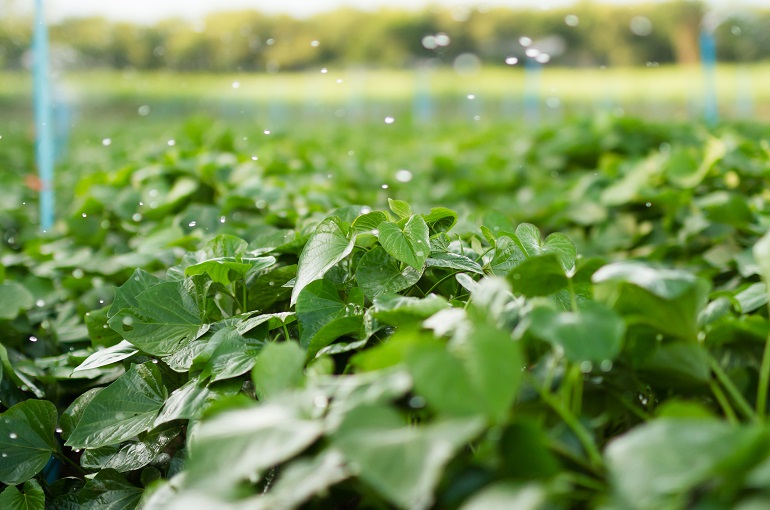Sweet Potato Water Requirements and Irrigation Systems

This post is also available in:
This post is also available in:
![]() Español (Spanish)
Español (Spanish) ![]() Deutsch (German)
Deutsch (German) ![]() Ελληνικά (Greek)
Ελληνικά (Greek)
How much water do sweet potatoes need?
Sweet potato is considered a mildly drought-tolerant plant. However, it seems to face a quality drop in low humidity conditions. It responds very well under irrigated conditions as optimum are considered 750-2,000 mm of annual rainfall. Irrigation is needed when the plants receive less than 800-850 mm of water from rainfall.
Water requirements are different during the various development stages of the plant. Generally, the critical period where sweet potatoes need the highest supply of water is during the root development-enlargement (4-5 weeks after slips’ planting). However, excessive water (waterlogging) during this stage can greatly reduce yields. During the first stages of plant development, many growers supply their plants with 18-20 mm per week. They follow this pattern until the mid-season when they start to provide 40 mm of water per week to the plants. They reduce the irrigation rate again by providing 20 mm of water per week during the maturity stages to avoid cracking of the roots and finally stop 2-3 weeks before harvesting to prevent the rotting of the sweet potatoes.
Of course, water requirements can also be different under different weather and soil conditions. For example, heavy clay soils usually need less irrigation than sandy soil. On the other hand, different sweet potato varieties may also have different water requirements. Large fluctuations in soil moisture should be avoided because they can reduce final yields. Sensors like tensiometers can be used in different soil depths to define the local needs of the soil better, the amount of water added, and the duration of irrigation. The measurements of these sensors (placed at 2.5 and 4.5 cm or 1 and 1.7 in) should be between 10 and 20 kPa (in light soils). Farmers generally prefer to irrigate their potatoes early in the morning or late in the evening so that the foliage has time to dry or/and avoid sunburns (in areas with intense sunlight and high temperatures). Watering the foliage has been linked with (fungal) disease outbreaks.
Recently, scientists who have experimented by inoculating mycorrhizae to sweet potato plants to boost their resistance to drought and increase growth and productivity, have obtained some promising results.
Sweet potato Irrigation Systems
In the areas where rainfalls are not sufficient or well-distributed throughout the growing season, most sweet potato farmers choose to irrigate. Sweet potatoes are usually irrigated using a center pivot, traveling gun, drip-irrigation (surface or subsurface), lateral move, and furrow-based systems. Depending on the area, the soil, the water availability, and the farmer, different systems are more popular than others. For example, in California (U.S.A), up to 95% of the sweet potato farmers use a drip irrigation system.
References
- https://www.colegiobolivar.edu.co/garden/wp-content/uploads/2017/06/NBleske-Ipomoea-batatas-2017.pdf
- https://journals.ashs.org/hortsci/view/journals/hortsci/50/7/article-p1011.xml
- https://www.hort360.com.au/wordpress/wp-content/uploads/2019/11/CB1_Sweet-Potato.pdf
- https://keys.lucidcentral.org/keys/sweetpotato/key/
- https://www.nda.agric.za/docs/Brochures/PG_SweetPotato.pdf
- https://mdpi-res.com/d_attachment/agronomy/agronomy-11-02019/
- https://agris.fao.org/agris-search/search.do?recordID=EG2011000335
Sweet Potato cultivation guide:
Fast Facts about Sweet Potatoes
Sweet Potato Plant Information and Variety Selection
Sweet Potato Nutrition and Health Benefits
How to Grow Sweet Potatoes in Your Backyard
How to Grow Sweet Potatoes for Profit
How to Produce Sweet Potato Slips
Sweet Potato Soil Requirements, Soil Preparation, and Planting
Sweet Potato Water Requirements and Irrigation Systems
Sweet Potato Fertilization Requirements
Sweet Potato Major Pests, Diseases and Weed Control








































































